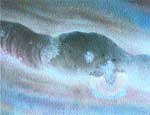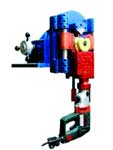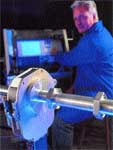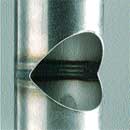Installing Clean Process Lines
Pharmaceutical Technology Europe
When planning the installation of a new stainless steel process pipeline, it is important to understand the significance of using the best possible materials and techniques to ensure it is clean when installed. This article examines the factors that must be considered when planning and constructing a new process line.
Accepted practices and operating procedures have been developed in the bio/pharmaceutical industry for the design, production and installation of process piping so that process systems operate in a clean and sterile manner. It is also understood that the materials of construction must not affect the purity of the product. An ideal process line will be designed to give the smoothest possible flow of product. To achieve this, the internal bore of the weld should be consistent throughout the entire system. To avoid potential contamination areas, known as 'bug traps,' the bore of the system should be smooth and free from marks and crevices. Bug traps are small voids in the material surface where product can stick and deteriorate during a period of time (Figure 1). By designing a system with predominantly welded joints, the number of problem areas is minimized; mechanical joints, by their nature, have areas that cause potential bug traps and should, therefore, be kept to a minimum.
Risks
If the line is not installed to a satisfactory standard, it will not last long and may contaminate the product travelling through it. The most important consideration when installing a stainless steel process line is to ensure that the steel will not degrade during installation, particularly during the welding operation.

Figure 1: A potential bug trap on a welded tube.
Stainless steels contain chromium and nickel, which give the material its stainless properties. If the steel is not adequately protected from oxygen during the welding process, it will dramatically degrade. Another serious risk to the product comes from pipelines that have not been thoroughly cleaned prior to use; any debris left in the system will contaminate the product flowing through it.

Figure 2: Egmo high quality fittings (Aalco, Bio-Pharm Division).
Creating clean lines
The main points to consider when creating a clean process pipeline are as follows:
- selection of tube and fittings
- tube fabrication techniques
- welding process and equipment
- application and control of welding
- post-installation cleaning and treatment of pipeline.
These points are discussed below.
Selection of tube and fittings
To achieve a clean process pipeline, it is important to select high quality tubes and fittings from a reliable source that can provide mill certification, chemical analysis and guarantee the quality of the tube finish (Figure 2). Tubes should be supplied from a controlled warehouse in protective packaging to eliminate any chance of tube contamination prior to installation. The following should be considered when selecting tubes and fittings:
- sulfur control
- surface finish
- manufacturer specifications
- batch control
- traceability.
Sulfur control. Stainless steels contain a trace amount of sulfur, which is not often considered a problem. In practice, however, sulfur content can have a major effect on the ability to weld the material. A difference of 0.001% in sulfur content can cause a significant difference to the weld profile; this is because of the Maragoni effect, which changes the surface tension temperature coefficient; that is, the heat movement in materials changes with different sulfur content.

Figure 3: Orbital cutting machine (Otto Tool, Inc.).
Surface finish. It is important that tubes and fittings have a smooth internal surface and that the supplier can guarantee this, particularly in welded tubes where the internal surface will be affected in the welded area.
Manufacturer specifications. There are many specifications to which tubing can be manufactured, but the most important regulation is ASME-BPE 1997. It is important that tubes should be manufactured with a statistical process control (SPC) production line to give guaranteed quality tubes.

Figure 4: An orbital welding system (Hewes Engineering).
Batch control. All tubes and fittings should be ordered by lot to ensure they are from the same batch of material. This ensures that all materials have the same sulfur content and will eliminate any problems with weld quality.
Traceability. All tubes and fittings should be traceable to their original source. This allows any problems encountered during fabrication, installation or service to be tracked back, and problems quickly identified and rectified.

Figure 5: Manually welded process tube (photo courtesy of Delstron Systems).
Tube fabrication techniques
During fabrication, it is important to follow recommended fabrication techniques to minimize contamination of the tube bore and material degradation. Each stage of pipeline fabrication has the potential to cause problems in the final process line. The main fabrication techniques used are cutting, tacking and welding.
Cutting. Lengths of tube will need to be cut to length during every stage of installation. To maintain the stainless properties, it is important to control the heat input during the cutting process; this would usually require an orbital cutting machine (Figure 3) with a well conditioned cutting blade. The use of other methods, or indeed an orbital cutting machine with a blunt blade, allows heat to build up during the cutting process and can degrade the material being cut. Overheating during cutting can be identified by the formation of oxides on the surface of the tube near to the cutting area.
Tacking. When tubes are cut to length, they will need to be tacked to fittings or other pipes to produce the required pipe run. The atmosphere in the internal bore should have an oxygen content of less than 500 ppm during tacking and welding so that the material does not degrade. The tack should also be small, clean and must not fully penetrate the wall of the material. Dirty tacks, which will be dark blue or black and in extreme cases may have a crusty surface, will also affect the quality of the final weld.

Figure 6: Orbital welded process tube (Delstron Systems).
Welding. Welding has the greatest degrading effect on the properties of the material and is one of the most complex and critical operations in the fabrication process.
Welding process and equipment
The most suitable process for welding stainless steel tubes is tungsten inert gas (TIG) welding. This process uses a non-consumable tungsten electrode that is shielded from the atmosphere by an inert gas, usually argon. This process provides a controlled heat source, which can be enhanced by a pulsed arc.

Figure 7: Fully enclosed weld head located on a process tube.
To attain high quality weld profiles and to minimize material degradation, a consistent weld speed must be used. The most effective way to control weld speed is to use an automatic orbital welding system (Figure 4). Figures 5 and 6 show the difference between a weld made by a manual pipe welder and a weld made with an orbital welding system. The manual weld is significantly more oxidized and less consistent than the automatic weld.
It is now considered standard practice to use orbital welding equipment with fully enclosed weld heads for pharmaceutical process line installation. Fully enclosed weld heads envelop the entire external surface of the weld area (Figure 7), which is then filled with an inert gas, usually argon, before the weld cycle starts. This guarantees a clean outer surface and should the joint open during the welding cycle, it is inert gas and not air that will be drawn into the internal bore.

Figure 8: Welded process tube with no back purge (Delstron Systems).
As well as protecting the external surface of the material, it is also essential that the internal surface is protected. If stainless steel is not protected from oxygen during the welding process, then the chromium and carbon in the material will be oxidized and form chromium carbides in a process known as coking (Figure 8). Once the chromium has been oxidized, the steel loses its corrosion resistance.
Oxidation can be avoided by filling the internal bore of the tube with an inert gas; this method is called back purging and a range of systems is available that localize the area at which the gas is applied, thus avoiding filling large sections of tube. These systems use a low volume of gas and reduce the time taken to get the oxygen level of the back purge to a suitably low level (Figure 9).
Application and control of welding
All welding should be performed to the highest standard and each weld must be tested and certified to that standard. If orbital welding equipment is used, the equipment and operators will also have to be certified. An approved weld procedure should be submitted with the certification and this weld procedure should be adhered to at all times. Modern welding equipment has the facility to store the weld procedure, limiting operators' ability to change the parameters. Test coupons should be submitted and approved prior to the welder commencing work on the installation. Further test coupons should be submitted to ensure that quality is continually being maintained.

Figure 9: Principle of an internal purge system (courtesy of Huntingdon Fusion Techniques).
All welds should be logged on the system diagram with a record of when welds were done and by whom. This helps if problems occur on a particular weld. Ideally, a data log will be kept for each weld; modern welding equipment can print or store this information and each log file will include date, time, weld number, welding current, travel speed and average arc voltage, and will record any deviations from programmed parameters.
The internal bore of the tube should also be filled with a suitable inert gas because the oxygen level should be less than 500 ppm before welding commences. Modern welding equipment can be connected to an oxygen analyser to prevent the weld operation beginning until the the oxygen has reached the required minimum level.
Post-installation cleaning and pipeline treatment
Because of fabrication, debris will remain in the system and this will have to be flushed out. In addition, all weld areas should be passivated as the metal crystalline configuration at the surface changes during cooling, resulting in depletion of the chromium oxide layer.
For post-installation treatment, the system is flushed with water to remove debris and a detergent is then circulated to remove oil, grease and organic residues. The system is then flushed again with water to remove all traces of the detergent. Valve bodies, diaphragms and other areas where debris may have accumulated are swabbed and then inspected under UV and white light to ensure that organic residues have been removed.
Nitric acid is then circulated to dissolve iron oxide and any other contaminants that have adhered to the steel. This is particularly important at weld areas where the metal is relatively rough and there is a possibility of iron oxide residue. Nitric acid is an oxyacid, which oxidizes the chromium layer at the metal surface to form resistant chromium oxide.
Even with electropolished biotubes, it is essential that the system is passivated to enrich the chromium oxide layer at the metal surface of the weld. Where nitric acid is unavailable or must be avoided because of safety or environmental reasons, other chemicals, such as mixtures of citric acids and organic chelants, can be used.The system is finally flushed with demineralized water to remove all traces of nitric acid.
On completion, a certificate is issued for validation purposes and ferroxyl tests, if required, are performed at weld areas. The ferroxyl test is an extremely sensitive test that can detect very low levels of iron.
Conclusion
A wide range of factors must be considered when constructing a clean process line. It is imperative that high quality materials and equipment are used to ensure longevity of the line. Full documentation will be required, which should include outline drawings, material quality certificates, weld data logs and all relevant specification conformance documentation, and all factors must be considered at the initial design stage.

Drug Solutions Podcast: A Closer Look at mRNA in Oncology and Vaccines
April 30th 2024In this episode fo the Drug Solutions Podcast, etherna’s vice-president of Technology and Innovation, Stefaan De Koker, discusses the merits and challenges of using mRNA as the foundation for therapeutics in oncology as well as for vaccines.